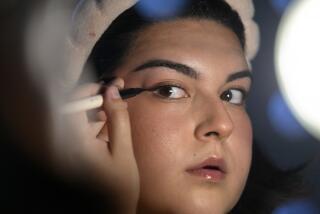On Pinterest, it’s share and share alike
Americans spend upward of 30 hours a month staring at their computer screens, shopping and browsing and seeking. We relish the efficiency, the expanse of information, the anonymity and the freedom. But we are social creatures and as such, can’t seem to stop gathering in various online communities to share music or photos of fabulous dinners or handbags.
We come together when rumors circle over a Kim Kardashian-Kanye West courtship or the replacement for John Galliano is announced at Dior. But nothing really says “Get to know me” quite like posting images of your favorite platforms or colored jeans, waiting for the social affirmation of a virtual thumbs up and comments from both real-life friends and those found throughout the Web. It’s a scrapbook world out there, and the fast and furious growth of such social networking sites says a great deal about the American psyche: We like it pretty, we like it easy (who says you can’t answer your boss’ question and share a funny cat video at the same time?) and we want to achieve this soothing state at the click of a mouse. Affirmation may very well be our national pastime — and declarations about personal style prompt a lot of the love.
It may even be psychologically healthy.
This all bodes well for the current social media darling Pinterest, a virtual bulletin board that lets its users showcase all the images, videos and witticisms that inspire them to make their own cookies, remodel their offices or create a perfect spring wardrobe. As is the modus operandi of most social media sites, Pinterest offers users a feeling of approval and the promise of a surge in popularity as friends comment on, “like” and share these newfound treasures on their own boards.
Even better: Pinterest and the numerous sites like it (Pinspire, anyone? Or perhaps the more testosterone-themed Manteresting? They don’t pin, they nail.) are free to use, meaning there is no financial limitation to this form of online self-expression. If you click on the photo’s link to another site and make a purchase, then hey, that’s on you.
Cincinnati-based fashion blogger Erin Flynn, 25, who is the co-founder of the site Righting Style, agrees that Pinterest is a great source for storing — in her case, sartorial — ideas, but it also allows her to connect with other fashion bloggers and share ideas. From a business perspective, Flynn likes that the site drives a lot of Web traffic (read: eyeballs) to her blog.
Alexandra Lippin, 31, a publicist in Los Angeles, admits that she first joined the site because she thought it would be a good resource for her clients, but now, well, she can’t stop Pinning.
“I look forward to going home and logging on,” Lippin says. “I use it for everything: shopping, party planning, recipes, décor ideas, etc. I have spent so much money in the last two months since I got into Pinterest as I keep finding things I want!”
Because these sites rely so much on positive visual appeal, they also allow users to interact with a community eager to share comforting ideas — as opposed to polarizing opinions or news stories that could cause a backlash of comments. Here, the worst-case scenario is that no one re-pins your image.
“What I get out of these sites is that they’re celebrations of the small things in life, because it’s these celebrations that change how you feel,” says Pamela Rutledge, director of the nonprofit Media Psychology Research Center (MPRC) and instructor of media psychology in the UCLA Extension program. “I find all these celebrations and creativity not just charming, but uplifting as a trend. We always had negative news because that’s what gets eyeballs for the 10 o’clock newscast, but we’ve never had the opportunity before to explore so many small, happy bits.”
Yes, a lot of the items people pin probably end up being more aspirational than inspirational — the sarcastic humor-themed greeting card site SomeeCards.com features a card that reads “I’m really looking forward to the non-existent wedding you’re planning on Pinterest” — but the site has also started a craze of “Pinterest parties” where (more often than not) women gather to show off the crafts and food and other niceties they created based on ideas they found on the site.
On a daily basis, technology news sites tout statistics of Pinterest’s meteoric rise. In January, Pinterest users spent an average of 89 minutes on the site. (By comparison, Twitter users were there for 21 minutes and users of the job-themed social network
LinkedIn spent 17 minutes on the site.) In March, it became the third most popular social media site in the United States, behind Facebook and Twitter. Pinterest users in the United States are reportedly mostly women between 25 and 34, and top brands on the site include Etsy, Kate Spade and HGTV.
Call it superficial window shopping if you want, but MPRC’s Rutledge argues that sites such as Pinterest can provide some insight into what makes that colleague down the hall tick.
“There’s a way of self-discovering as a way of sharing because you’re not overtly saying ‘I Love Trees’ or whatever,” says Rutledge. Much like body language, “you’re leaving it for people to infer.”
So, yes, sharing your love for the new Gregory Parkinson line at Anthropologie or Frye boots says a lot without giving away your entire psychological store. This you-figure-it-out mentality could be precisely what’s needed in a social media landscape of ever-changing privacy settings where our professional, home and social lives are all intertwined online — these visual sites give us the affirmation fix we crave without the cost of committing our thoughts to text.
“Social networks and apps remind me of show-and-tell days in elementary school where I choose what I want the world to see, but I also pick what I want to keep private,” says Brian Hernandez, culture editor for social media news site Mashable. “I think that’s a smart way to look at social media. Our online presence should be an extension of who we are, [but] it’s not what defines us.”
It helps that Pinterest and sites like it are on trend, as social media is quickly moving toward a more image-oriented landscape that not only simplifies but speeds up the mental affirmation process. Just as in a clothing store when you instantly get a sense of outfits to take to the dressing room, social sites’ photographic displays help us instantly decide if we find an image to be pleasing, pretty or interesting. Facebook, for example, has incorporated a visual timeline and recently acquired the mobile application Instagram, a photo retouching tool that bathes otherwise average closet-raid photo shoots in patinas of soft, faux-vintage light. You can even view your Facebook page in a Pinterest-style manner with the Pinview application. Twitter allows photos and videos to appear in updates, and the microblogging site Tumblr makes it easy to share and re-share content with a quick click.
“There’s suddenly what’s being referred to as the visual multiplier,” says Alexis Madrigal, a senior editor at the Atlantic who covers technology. “It’s easier to share and pass around photos and videos than it is to pass around text. … When we’re talking about people who are processing information quickly, the idea that a photo is a thousand words might actually be provably true.”


